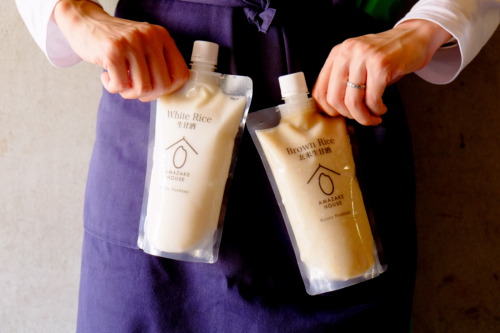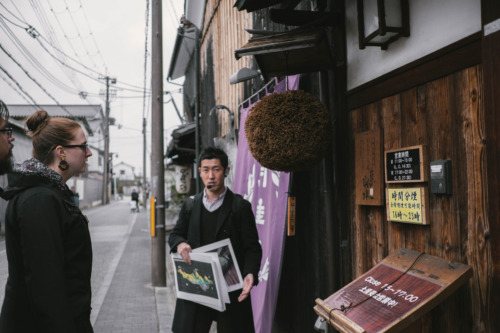Though amazake is popular as a drink for your beauty and health, there are many types of amazake at the store, and it is not easy to find the right one for you. You may end up disliking amazake if you choose an amazake that does not taste good, or you may not get the effect you are looking for if you choose the wrong one.
In this article, we will explain the key points for selecting amazake that is “easy to drink” and “high nutritional value and helps intestinal function“, respectively.
In fact, these two are basically completely opposite. Let’s get started!

How to Choose ‘Easy to Drink’ Amazake?
For those who want to choose an amazake that is refreshing and is easy to drink, we recommend amazake made by a sake brewery that produces sake. For example, “Dassai Amazake” by Asahi Shuzo brewery, which brews famous sake Dassai, is so refreshing and peculiarly sweet that even those who do not like amazake can enjoy it. The reason for this is the type of rice used as ingredients and the ratio of polished rice. Even if it is not amazake made by a sake brewery, amazake is probably easy to drink if it meets the following conditions.
Know the Differences of types of rice
One of the reasons why amazake from sake breweries that produce sake is so easy to drink is the type of rice used. The sake rice can be broadly divided into;
- rice that we usually eat (e.g. Koshihikari)
- Sake rice used exclusively for sake brewing (e.g. Yamada-Nishiki)
Amazake made by sake breweries is often made from the sake rice.
Sake rice is characterized by its low content of proteins and other substances that can cause unpleasant tastes when made into sake, and by the presence of a starch-rich portion in the center of each rice. Sake rice such as Yamada-Nishiki tends to have a crisp, light flavor, so when it is used to make amazake, it tends to produce a refreshing amazake.
Know the Differences by Rice Polishing Ratio
The second reason why amazake from a sake brewery is easy to drink is their rice polishing ratio.
Nutrients in rice such as proteins and fats are found in the outer part of the rice. The white rice we usually eat is brown rice with only 10% of the outer layer removed, and the remaining 90% is eaten. This remaining 90% is called rice polishing ratio.
Polishing ratio 90% = 10% of the rice is milled and the remaining 90% is used.
Sake breweries use advanced milling techniques to make sake by milling much more rice than this. The rice polishing ratio of the rice we eat is 90%. Sake can be made with milling ratios as low from 70% to 50%. Basically, the more polished the rice (especially rice suitable for sake brewing), the higher the percentage of starch and the cleaner the taste. Accordingly, amazake with rice that has been polished to a low ratio will result in a clear and refreshing amazake.
For your information, “Dassai Amazake” is 50%, and “Amazake made only with koji” by Hakkaisan, which is often seen in supermarkets, is 60%.
Is It Amazake with Only Rice Malt or Mix of Rice Malt and Rice?
The third point is not directly related to the brewery, but if the ingredients are
- Only rice malt
- rice malt and rice
First of all, koji, rice malt has a peculiar flavor when eaten. There are various tastes depending on the strain and how it is made. And this koji flavor is clearly effect directly in amazake.
Therefore, in amazake with only “rice koji” as an ingredient, you can clearly taste this koji flavor. This is fine if you like the flavor of koji, but some people may not like it.
On the other hand, if the ingredients are listed as “rice malt and rice,” steamed or cooked rice (called kakemai) is added to the rice malt, so the koji flavor is reduced.
If you want to choose an easy-to-drink amazake with less koji flavor, we recommend amazake with “rice koji and rice” in the ingredients.
Less Degradation Due to Maillard Reaction
Mass-produced amazake, which takes a long time to reach us after production, deteriorates in flavor over time due to the Maillard reaction, in which sugar, proteins, amino acids, and other substances combine. This Maillard reaction is what makes amazake not so refreshing. As the Maillard reaction progresses, the color changes to brown.
Another reason why sake breweries’ amazake is easier to drink is that they use sake rice and polish the rice more to reduce the amount of protein in the amazake, which causes the Maillard reaction.
It is also important to note that amazake is sold under refrigeration because the Maillard reaction occurs at higher temperatures.
Summary – What Makes Amazake Easy-to-Drink?
- Yamada-Nishiki or other sake rice is used.
- High rice polishing ratio.
- “rice koji and rice” are listed on the ingredient.
- Sold under refrigeration.
If you are looking for the perfect one, Dassai Amazake (獺祭 甘酒) meets all of the above conditions. It is recommended for those who are looking for an easy-to-drink amazake.
How to Choose Amazake with High Nutritional Value and Helps Intestinal Function
To begin with, amazake is made by enzymes produced by koji, which break down rice starch into glucose and oligosaccharides, and proteins into amino acids, peptides, and other nutrients.
First of all, the definition of nutritious amazake;
Amazake is rich in nutrients other than sugar, including amino acids, fatty acids, vitamins, and minerals
The definition of amazake, which is highly effective for helping intestinal function;
Amazake rich in oligosaccharides and dietary fiber to increase beneficial bacteria in the intestinal flora
Defined as above, the key to choosing amazake with high nutritional value and helps intestinal function is the exact opposite of the first two points listed in the conditions for easy-to-drink amazake!
Rice for Eat is More Suitable
Sake made from rice such as Yamada-Nishiki, which is characterized by its low protein content and clean taste, is low in protein, which in turn means that it is low in nutrients such as amino acids and peptides. Therefore, if you want to choose amazake rich in nutrients such as amino acids and peptides, it is better to choose amazake made from rice that is rich in nutrients (most amazake other than sake breweries’ amazake is made from rice).
Low Milled Rice Rather Than High Milled Rice
Nutrients such as protein, fat, minerals, vitamins, and fiber are found mostly on the outside of the rice. By grinding more rice, these nutrients are removed and the easy-to-drink amazake, which has a refreshing taste, is naturally lower in nutritional value. In particular, dietary fiber, which like oligosaccharide increases beneficial bacteria and cleanses the intestinal tract, is much reduced when rice is polished. Therefore, if nutritional value and helping intestinal function are important, the best amazake is made from brown rice with a milling ratio of 90% or 100% of ordinary white rice, rather than 50% or 60% of polished rice. Brown rice contains about six times more dietary fiber than white rice.
Summary – What Makes Amazake High Nutritional Value and Helps Intestinal Function
- Amazake made with rice, not sake rice
- Amazake made with rice that has not been polished much
- Brown rice amazake is, after all, the best!
When considering the nutritional value and intestinal activity effects, the conditions for selecting amazake that is easy to drink are exactly the opposite of those for amazake.
However, since this highly nutritious amazake is also high in protein and amino acids, if it is stored for a long time for distribution, the flavor will deteriorate greatly due to the Maillard reaction.
You want the nutritional value and helping intestinal function, but you want it to be easy to drink! Perhaps most of you are looking for this perfect amazake.
Let’s check out raw amazake, which can be the best solution!
What is Raw Amazake and Why Is It the Best?
Why Raw Amazake Tastes Delicious
Raw amazake is amazake that has not been heat-sterilized in which the temperature is further raised after fermentation at the usual 55-60°C.
Ordinary amazake on the market is heat-sterilized at around 85 degrees Celsius to keep it for a longer period of time for distribution at room temperature or refrigerated. (For more information on raw amazake, please refer to the following article.)
The difference between the popular raw amazake and mass-produced amazake #11(To be published at a later date)
A toji (master brewer) of a certain sake brewery said, “I couldn’t make really good amazake by fire-quenching and I think raw amazake is the best.” We at AMAZAKE HOUSE also believe that freshly brewed amazake is the best amazake.
Raw amazake is not pasteurized, so it is basically kept refrigerated and consumed within a few days to a week after it is made.
The disadvantage of raw amazake is that it does not last long, but the flip side of that is that it does not suffer from the deterioration of flavor caused by the Maillard reaction that occurs when stored at room temperature or refrigerated in the first place! If you choose raw amazake, even ones made from 90% polished white rice or brown rice tastes great because it is freshly made.
AMAZAKE HOUSE’s Raw Amazake
AMAZAKE HOUSE produces raw amazake made with 90% polished white rice and raw amazake made with brown rice in order to achieve high nutritional value and easy drinking.
- The rice for eating is used
- The ratio of polished rice is 90% for white rice with emphasis on nutritional value, 97% for brown rice amazake with 97% koji (three parts koji), and 100% for brown rice with 100% koji.
- The koji is originally blended
- Rice is added to bring out the gentle sweetness of the rice so that the flavor of the koji does not come out too strongly.
- Products online are frozen at its best taste by letting it sit overnight after fermentation so that the flavor does not deteriorate.
Summary
In this article, we explained the key points for selecting amazake. If you are looking for both nutritional value and smooth drinking, you should choose one of the raw amazake. Especially brown rice raw amazake with plenty of dietary fiber is recommended for those who value its healthy effects!

Born in Kyoto City, Japan. International sake taster and brewing manager of AMAZAKE HOUSE, a specialty store for raw amazake. After living in the U.S. and Australia, he is now promoting the culture of sake, amazake, and koji to the world in Fushimi, Kyoto. His Kyoto Insider Sake Experience is the most popular sake experience among foreigners on TripAdvisor.

Born in Kyoto City. International sake taster and brewing manager of AMAZAKE HOUSE, a specialty store for raw amazake. After living in the U.S. and Australia, he is currently working in Fushimi, Kyoto, to promote the culture of sake, amazake, and koji to the world.


